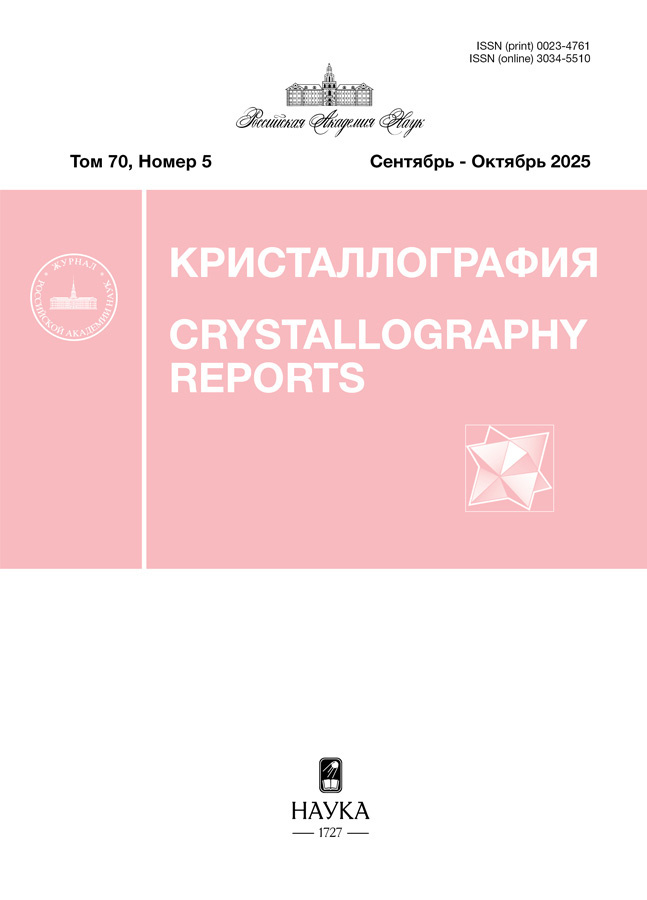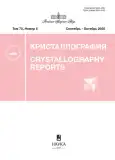Growth Features of the Guanylurea Hydrogen Phosphite Single Crystal
- Authors: Kozlova N.N.1, Rudneva E.B.1, Komornikov V.A.1, Manomenova V.L.1, Voloshin A.E.1,2,3
-
Affiliations:
- Shubnikov Institute of Crystallography of the Kurchatov Complex Crystallography and Photonics of the NRC “Kurchatov Institute”
- Mendeleev University of Chemical Technology of Russia
- National University of Science and Technology “MISIS”
- Issue: Vol 70, No 5 (2025)
- Pages: 837-845
- Section: CRYSTAL GROWTH
- URL: https://modernonco.orscience.ru/0023-4761/article/view/693872
- DOI: https://doi.org/10.31857/S0023476125050153
- EDN: https://elibrary.ru/vgqezn
- ID: 693872
Cite item
Abstract
About the authors
N. N. Kozlova
Shubnikov Institute of Crystallography of the Kurchatov Complex Crystallography and Photonics of the NRC “Kurchatov Institute”
Email: kozlova.n@crys.ras.ru
Moscow, 119333 Russia
E. B. Rudneva
Shubnikov Institute of Crystallography of the Kurchatov Complex Crystallography and Photonics of the NRC “Kurchatov Institute”Moscow, 119333 Russia
V. A. Komornikov
Shubnikov Institute of Crystallography of the Kurchatov Complex Crystallography and Photonics of the NRC “Kurchatov Institute”Moscow, 119333 Russia
V. L. Manomenova
Shubnikov Institute of Crystallography of the Kurchatov Complex Crystallography and Photonics of the NRC “Kurchatov Institute”Moscow, 119333 Russia
A. E. Voloshin
Shubnikov Institute of Crystallography of the Kurchatov Complex Crystallography and Photonics of the NRC “Kurchatov Institute”; Mendeleev University of Chemical Technology of Russia; National University of Science and Technology “MISIS”Moscow, 119333 Russia; Moscow, 125047 Russia; Moscow, 119049 Russia
References
- Beard M.C., Turner G.M., Schmuttenmaer C.A. // J. Phys. Chem. B. 2002. V. 106. № 29. P. 7146. https://doi.org/10.1021/jp020579i
- Sinko A., Ozheredov I., Rudneva E. et al. // Electronics. 2022. V. 11. № 17. P. 2731. https://doi.org/10.3390/electronics11172731
- Sinko A., Solyankin P., Kargovsky A. et al. // Sci. Rep. 2021. V. 11. № 1. P. 23433. https://doi.org/10.1038/s41598-021-02862-3
- Fridrichova M., Nemec I., Cisarova I. et al. // Cryst EngComm. 2010. V. 12. № 7. P. 2054. https://doi.org/10.1039/B924973G
- Kroupa J. // J. Opt. 2010. V. 12. 045706. https://doi.org/10.1088/2040-8978/12/4/045706
- Kroupa J., Fridrichova M. // J. Opt. 2011. V. 13. 035204. https://doi.org/10.1088/2040-8978/13/3/035204
- Fridrichova M., Kroupa J., Nemec I. et al. // Phase Transitions. 2010. V. 83. № 10–11. P. 761. https://doi.org/10.1080/01411594.2010.509044
- Kaminskii A.A., Becker P., Rhee H. et al. // Phys. Status Solidi. B. 2013. V. 250. № 9. P. 1837. https://doi.org/10.1002/pssb.201349201
- Каминский А.А., Маноменова В.Л., Руднева Е.Б. и др. // Кристаллография. 2019. Т. 64. № 4. С. 645. https://doi.org/10.1134/S002347611904009X
- Glikin A.E., Kovalev S.I., Rudneva E.B. et al. // J. Cryst. Growth. 2003. V. 255. № 1–2. P. 150. https://doi.org/10.1016/S0022-0248(03)01189-8
- Tanner B.K. X-ray diffraction topography. New York: Pergamon Press, 1976. P. 174.
- Воронцов Д.А., Ершов В.П., Портнов В.Н. и др. // Вестник Нижегородского университета им. Н.И. Лобачевского. 2010. № 4. С. 49.
- Ефремова Е.П., Кузнецов В.А., Климова А.Ю. // Кристаллография. 1993. Т. 38. Вып 5. С. 171.
- Liu F., Lisong Z., Yu G. et al. // Cryst. Res. Technol. 2015. V. 50. № 2. P. 164. https://doi.org/10.1002/crat.201400304
Supplementary files








